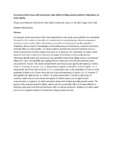Please use this identifier to cite or link to this item:
https://cris.library.msu.ac.zw//handle/11408/1720| Title: | Assessing nutrient losses with soil erosion under different tillage systems and their implications on water quality | Authors: | Munodawafa, Adelaide | Keywords: | Nutrient losses; Soil erosion; Tillage; Water quality | Issue Date: | 2007 | Publisher: | Elsevier | Series/Report no.: | Physics and Chemistry of the Earth, Parts A/B/C;Vol. 32, Issues 15–18; p. 1135–1140 | Abstract: | An increased public perception of the role of agriculture in non-point source pollution has stimulated the need for information on the effect of conventional and sustainable agricultural management systems on water quality. While information on run-off and soil erosion is readily available in Zimbabwe, there is dearth of knowledge on the relative losses of nutrients as a result of soil erosion and their effect on water quality. This study sought to quantify the amount of nutrients lost as a result of soil erosion and thus enable conclusions to be drawn on the implications on water quality. Research work was carried out in the semi-arid region of Zimbabwe under granite-derived, inherently infertile sandy soils. Soil erosion was quantified under three tillage systems conventional tillage (CT); mulch ripping (MR); tied ridging (TR) over three years. Run-off and sediments were analysed for N, P and K. The results showed that N and K losses were significantly higher (p < 0.001) under CT (15.8 and 34.5 kg ha−1 yr−1, respectively) compared to the MR (2.3 and 0.6 kg ha−1 yr−1, respectively) and TR (2.7 and 4.3 kg ha−1 yr−1, respectively). Due to the immobility of P and its small quantities in these soils, P losses were also low across all treatments (<1 kg ha−1 yr−1), however CT had significantly higher losses (p < 0.001). The study showed that CT results in high losses of nutrients, which would in turn reduce the quality of surface waters, due to high nutrient concentrations of especially, N, which stimulates the growth of algae and other aquatic weeds. The gravity of the situation would be higher, where soils are more fertile. MR and TR were efficient in reducing soil erosion and thus nutrient losses with run-off and sediments. Pollution of surface water sources can be greatly reduced if conservation tillage systems are used. | Description: | Abstract | URI: | http://www.sciencedirect.com/science/article/pii/S1474706507001180 http://hdl.handle.net/11408/1720 |
ISSN: | 1474-7065 |
| Appears in Collections: | Research Papers |
Files in This Item:
| File | Description | Size | Format | |
|---|---|---|---|---|
| Assessing nutrient losses.pdf | 215.25 kB | Adobe PDF |  View/Open |
Page view(s)
160
checked on Nov 23, 2025
Download(s)
38
checked on Nov 23, 2025
Google ScholarTM
Check
Items in MSUIR are protected by copyright, with all rights reserved, unless otherwise indicated.



